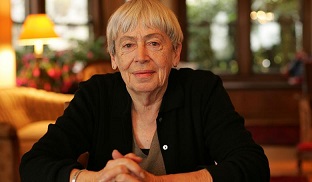De Amerikaanse schrijfster Ursula Kroeber Le Guin werd geboren als Ursula Kroeber in Berkeley, Californië op 21 oktober 1929. Haar vader, Alfred L. Kroeber, was antropoloog, haar moeder, Theodora Kroeber, schrijfster. Ze was gehuwd met Charles A. Le Guin, een historicus. Ze studeerde aan Radcliffe College en Columbia University, waar ze in 1952 haar MA haalde. Negen andere universiteiten hebben haar eredoctoraten toegekend. Ze heeft Frans en Schrijven gedoceerd aan vele universiteiten. Haar oeuvre omvat verder 28 romans en 11 collecties korte verhalen. Thema’s die in haar werk een rol spelen zijn vaak feministisch, psychologisch, sociologisch of anarchistisch van aard. Bekende boeken van haar hand zijn onder andere de Aardzee-serie, “Duisters linkerhand” (The Left Hand of Darkness) en “De ontheemde” (The Dispossessed). Ze heeft een groot aantal prijzen gewonnen, waaronder vijf Hugo Awards en zes Nebula Awards, de twee bekendste onderscheidingen voor sciencefiction.
Uit: The dispossessed
“There was a wall. It did not look important. It was built of uncut rocks roughly mortared. An adult could look right over it, and even a child could climb it. Where it crossed the roadway, instead of having a gate it degenerated into mere geometry, a line, an idea of boundary. But the idea was real. It was important. For seven generations there had been nothing in the world more important than that wall.
Like all walls it was ambiguous, two-faced. What was inside it and what was outside it depended upon which side of it you were on.
Looked at from one side, the wall enclosed a barren sixty-acre field called the Port of Anarres. On the field there were a couple of large gantry cranes, a rocket pad, three warehouses, a truck garage, and a dormitory. The dormitory looked durable, grimy, and mournful; it had no gardens, no children; plainly nobody lived there or was even meant to stay there long. It was in fact a quarantine. The wall shut in not only the landing field but also the ships that came down out of space, and the men that came on the ships, and the worlds they came from, and the rest of the universe. It enclosed the universe, leaving Anarres outside, free.
Looked at from the other side, the wall enclosed Anarres: the whole planet was inside it, a great prison camp, cut off from other worlds and other men, in quarantine.
A number of people were coming along the road towards the landing field, or standing around where the road cut through the wall.
People often came out from the nearby city of Abbenay in hopes of seeing a spaceship, or simply to see the wall. After all, it was the only boundary wall on their world. Nowhere else could they see a sign that said No Trespassing. Adolescents, particularly, were drawn to it. They came up to the wall; they sat on it. There might be a gang to watch, offloading crates from track trucks at the warehouses. There might even be a freighter on the pad. Freighters came down only eight times a year, unannounced except to syndics actually working at the Port, so when the spectators were lucky enough to see one they were excited, at first. But there they sat, and there it sat, a squat black tower in a mess of movable cranes, away off across the field. And then a woman came over from one of the warehouse crews and said, “We’re shutting down for today, brothers.” She was wearing the Defense armband, a sight almost as rare as a spaceship. That was a bit of a thrill. But though her tone was mild, it was final. She was the foreman of this gang, and if provoked would be backed up by her syndics. And anyhow there wasn’t anything to see. The aliens, the off-worlders, stayed hiding in their ship. No show.”

Ursula Le Guin (Berkeley, 21 oktober 1929)
